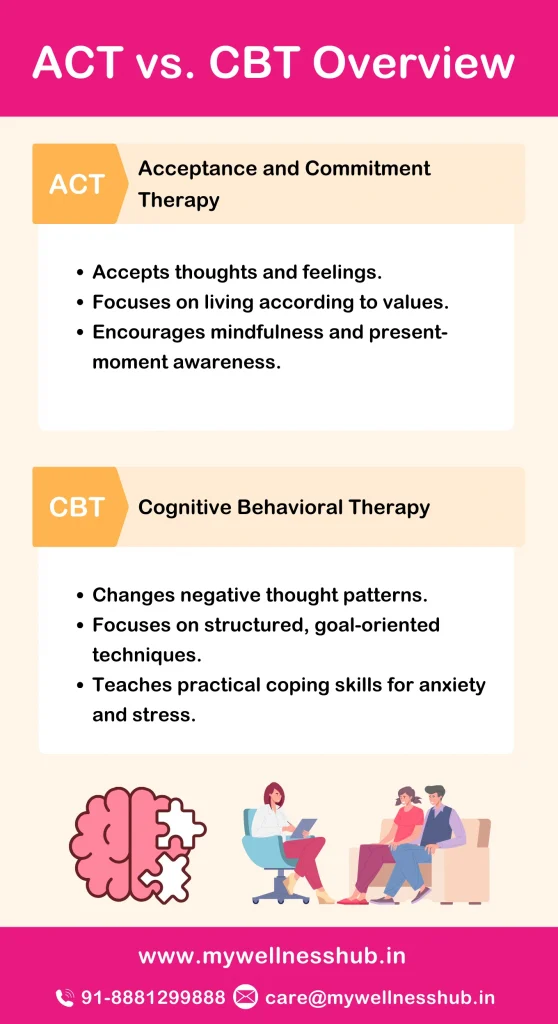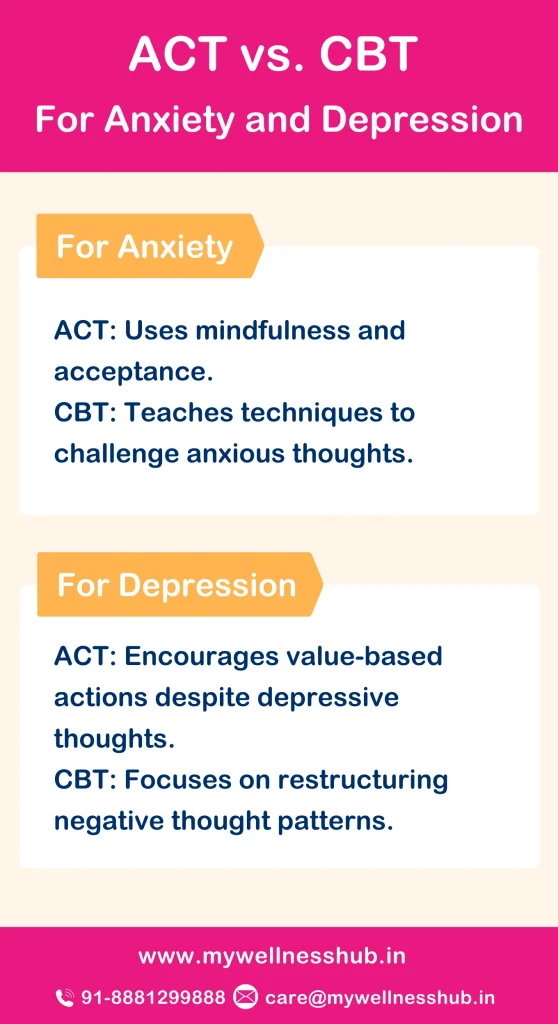ACT and CBT: Which Therapy is Best for You?
Last Updated: January 7, 2025
When it comes to taking care of our mental health, choosing the right therapy can make all the difference. If you’re considering starting therapy or exploring different approaches, two of the most well-known and effective options are Acceptance and Commitment Therapy (ACT) and Cognitive Behavioral Therapy (CBT).
Both ACT and CBT are designed to help improve mental well-being, but they take different routes to get there. While CBT aims to change how you think and behave, ACT focuses more on accepting your thoughts and feelings and finding ways to move forward. But how do you know which one is right for you?

What is ACT (Acceptance and Commitment Therapy)?
Let’s start by understanding ACT, which stands for Acceptance and Commitment Therapy. Imagine dealing with difficult thoughts or emotions—whether it’s stress, anxiety, or even self-doubt. Your first instinct might be to change or get rid of them, right? But ACT takes a different approach.
Instead of fighting your thoughts or trying to control your feelings, ACT helps you accept them as they are. The idea is to acknowledge whatever thoughts and emotions you have without letting them control your actions. This way, you can commit to taking meaningful actions that align with your personal values. This approach is why ACT is often referred to as a “mindfulness-based therapy.”
Key Concepts of ACT
- Mindfulness:
A core part of ACT is mindfulness—being present in the moment. Mindfulness helps you notice your thoughts and emotions without getting caught up in them. It’s like watching your thoughts go by as if they were leaves floating down a stream. Practicing mindfulness enables you to stay connected to the present, rather than dwelling on the past or worrying about the future. - Acceptance:
Now, acceptance doesn’t mean giving up or ignoring your problems. It’s about allowing your thoughts and feelings to exist without fighting against them. Think of it as making room for both the good and the bad, allowing them to be present without harsh judgment or avoidance. This acceptance is what allows you to keep moving forward, even when things feel tough. - Values-Based Action:
One of the key elements of ACT is values-based action. It encourages you to take actions that are consistent with what truly matters to you. This means identifying your core values—like family, honesty, personal growth—and making choices that align with those values, even if you’re experiencing uncomfortable thoughts or emotions. Essentially, ACT guides you to lead a life that is meaningful to you, regardless of any internal struggles.
When is ACT Used?
ACT can be helpful in a variety of situations. It’s commonly used for managing anxiety, depression, chronic pain, and even conditions like obsessive-compulsive disorder (OCD) or post-traumatic stress disorder (PTSD). It’s especially effective when you feel “stuck” or find yourself constantly battling with your thoughts and feelings. For example, if anxiety is preventing you from going after what you want in life, ACT can help you make peace with those feelings while still moving toward your goals.
What is CBT (Cognitive Behavioral Therapy)?
Now, let’s shift our focus to CBT, which stands for Cognitive Behavioral Therapy. If you’ve ever felt like your thoughts and feelings were holding you back, CBT might be a term you’ve come across. But what exactly is it?
CBT is a widely used form of talk therapy aimed at identifying and changing unhelpful or negative thought patterns. The idea is simple: how we think affects how we feel, and how we feel impacts how we act. By challenging negative thoughts and behaviors, CBT helps you develop healthier ways to approach life’s challenges. It’s a very hands-on, goal-oriented therapy designed to provide practical solutions for improving mental health.
Key Concepts of CBT
- Cognitive Restructuring
At the core of CBT is cognitive restructuring, which is all about becoming aware of your negative thought patterns and then challenging them. Let’s say you often think, “I’m not good enough.” In CBT, you’d learn to question these thoughts: Is there evidence for this belief? Are there alternative ways to see the situation? By reworking these thoughts into something more balanced and realistic, you can shift how you feel and behave. - Behavioral Changes
CBT isn’t just about thinking differently—it’s also about taking action. Often, the therapy includes setting small, achievable goals to change behaviors that are contributing to your distress. For example, if you struggle with social anxiety, CBT might encourage you to practice gradual exposure to social situations, helping to reduce fear over time. The behavioral element helps you build confidence, improve mood, and practice new skills. - Skill Development
A major benefit of CBT is the emphasis on skill development. Throughout your sessions, you’ll learn coping mechanisms to manage stress, anxiety, and depression more effectively. These might include relaxation techniques, problem-solving skills, or strategies to improve time management. By practicing these tools, you can develop lifelong habits that contribute to better mental well-being.
When is CBT Effective?
CBT has been found to be effective for a wide range of issues, making it a versatile option for many people. It’s commonly used to treat:
- Anxiety Disorders: CBT helps to reduce anxiety by challenging catastrophic thinking and gradually confronting fears.
- Depression: It assists in changing negative thought patterns and encourages activities that improve mood.
- Phobias: CBT is effective in helping people gradually face and overcome their fears.
- Other Issues: CBT can also help with obsessive-compulsive disorder (OCD), post-traumatic stress disorder (PTSD), eating disorders, and sleep problems.
Also Read: 14 Effective Cognitive Behavioral Therapy Activities to Help Kids
ACT vs. CBT: Key Differences
Now that you know a bit about both ACT and CBT, let’s break down how they differ. While both therapies aim to improve mental health and well-being, they take quite different approaches. Understanding these differences can help you figure out which might be more suitable for you.
Approach to Thoughts
One of the main differences between ACT and CBT lies in how each therapy approaches thoughts and feelings.
- ACT (Acceptance and Commitment Therapy):
In ACT, the goal is not to change your thoughts but to accept them. You learn to observe your thoughts and feelings without judgment, almost like being a spectator. The aim is to develop a healthier relationship with your inner experiences, allowing them to be present without letting them dictate your actions. For instance, if you often feel “I’m not good enough,” ACT would encourage you to accept that feeling as a thought—not as a fact—and focus on living your values despite it. - CBT (Cognitive Behavioral Therapy):
CBT, on the other hand, is all about challenging and changing negative thoughts. If you have an unhelpful belief—such as “I always fail”—CBT encourages you to question this thought, look for evidence against it, and replace it with a more balanced perspective. The goal is to reshape your thinking patterns, helping you see situations more clearly and positively.
ACT vs. CBT at a Glance
| Aspect | ACT (Acceptance and Commitment Therapy) | CBT (Cognitive Behavioral Therapy) |
|---|---|---|
| Goal | Acceptance of thoughts and commitment to value-based actions | Identifying and challenging negative thoughts and behaviors |
| Approach | Mindfulness and acceptance | Cognitive restructuring and skill development |
| Focus | Living in line with values | Changing unhelpful beliefs and behaviors |
| Use of Mindfulness | Heavy focus on mindfulness practices | Some mindfulness techniques but not the main focus |
| When to Use | For those struggling with chronic conditions, existential issues, or value-based living | For those seeking practical tools to manage anxiety, stress, or mood disorders |
| Duration of Therapy | Varies; can be longer based on individual needs | Typically 8-12 sessions, with structured progress |
Focus on Values vs. Beliefs
Another key difference lies in what each therapy emphasizes.
- ACT’s Focus on Values:
ACT encourages you to live according to your values, regardless of the thoughts and feelings that may come up. Values in ACT are like your life’s compass—they guide your actions and help you create a meaningful life. For example, if “kindness” is a core value for you, ACT will encourage you to take actions that align with being kind, even if you’re feeling anxious or down. - CBT’s Focus on Beliefs:
In contrast, CBT focuses on beliefs and how they influence your thoughts, feelings, and behaviors. It works to shift unhelpful or distorted beliefs that might be contributing to issues like anxiety or depression. By addressing these beliefs, CBT aims to improve mood and functioning. For example, if you believe “I will never succeed,” CBT works to adjust this belief to something more balanced and constructive.
Mindfulness and Present Moment
Both ACT and CBT include elements of mindfulness, but they approach it differently.
- Mindfulness in ACT:
Mindfulness is a core element of ACT, and it’s all about staying present and fully experiencing the moment without getting entangled in thoughts and emotions. In ACT, mindfulness helps you observe your internal experiences (like thoughts and feelings) from a distance, allowing you to engage in values-based actions even when faced with challenging emotions. - Mindfulness in CBT:
While CBT uses some mindfulness techniques, its main focus is on cognitive restructuring—identifying and reshaping negative thoughts—and developing practical skills to manage challenges. CBT is more structured and goal-oriented, aiming for measurable changes in thinking and behavior.
Benefits of ACT (Acceptance and Commitment Therapy)
So, why might you choose ACT as a therapeutic approach? Let’s take a closer look at some of the key benefits that make ACT a unique and effective form of therapy.
1. Teaches Acceptance and Reduces Struggle with Thoughts
One of the core benefits of ACT is its focus on acceptance. Instead of wrestling with negative thoughts and trying to change or control them, ACT teaches you to accept them for what they are—just thoughts. By doing so, you reduce the inner struggle that comes from battling your own mind.
Imagine a scenario where you’re feeling anxious about an upcoming presentation. Instead of telling yourself, “I shouldn’t feel this way,” ACT encourages you to notice the anxiety, acknowledge it, and still go ahead with the presentation, living in line with your values. This approach reduces the burden of trying to “fix” your thoughts and makes it easier to handle stressful situations.
2. Helps Build a Deeper Connection with One’s Values
ACT is all about connecting with what truly matters to you—your values. Unlike some therapies that focus solely on symptom reduction, ACT encourages you to live a meaningful life based on your core values, whether that’s family, creativity, helping others, or self-improvement.
For example, if one of your values is “being a supportive friend,” ACT helps you focus on actions that support that value, even if you’re feeling insecure or self-doubtful. By prioritizing values-based actions, you create a sense of purpose and fulfillment, regardless of the internal thoughts or emotions you’re experiencing. This can lead to lasting positive changes and a life that feels more aligned with who you want to be.
3. Often Used for Chronic Conditions and Stress
Another major benefit of ACT is its versatility. It’s particularly effective for managing chronic conditions—like long-term stress, chronic pain, and ongoing mental health challenges such as anxiety and depression. Because ACT teaches acceptance and commitment to values, it’s a great fit for conditions where “fixing” or “getting rid” of the problem may not be possible.
In cases like chronic pain, ACT doesn’t try to eliminate the pain itself but focuses on helping individuals accept the pain and commit to living a full life despite it. The same goes for emotional struggles, like grief or ongoing stress; ACT can be a powerful way to build resilience and continue moving toward the life you want.
Benefits of CBT (Cognitive Behavioral Therapy)
Cognitive Behavioral Therapy (CBT) is one of the most widely used and researched forms of therapy, and it’s no surprise why. If you’re someone looking for actionable tools and quick results, CBT might be a great fit. Let’s explore the key benefits that make CBT a popular choice for many.
1. Provides Practical Tools for Managing Thoughts and Behaviors
One of the main benefits of CBT is its practical approach. Rather than just exploring why you feel a certain way, CBT provides clear tools and strategies to help you understand and change how you think and behave. This is why CBT is often described as a “skills-based” therapy.
For example, if you tend to think, “I always mess things up,” CBT will teach you how to challenge that thought by looking for evidence against it or reframing it in a more balanced way. This hands-on approach can help you quickly manage day-to-day issues, whether it’s a tough work situation, relationship challenges, or a personal struggle with self-doubt.
2. Helps Develop Healthy Coping Mechanisms for Anxiety and Depression
CBT is particularly effective for managing anxiety and depression, as it provides tools to develop healthy coping mechanisms. You learn to recognize unhelpful thought patterns and replace them with more constructive and realistic thoughts. These changes in thinking naturally lead to changes in behavior, helping you to feel more in control.
For anxiety, this might involve learning to challenge fears or gradually expose yourself to situations that cause discomfort, allowing you to build confidence over time. For depression, CBT often focuses on helping you break out of negative thinking cycles and encourages activities that improve your mood and well-being.
3. Focuses on Measurable Progress and Quick Relief from Symptoms
CBT is often seen as a goal-oriented and time-limited therapy, meaning it aims to help you see measurable progress relatively quickly. Typically, CBT programs last between 8 to 12 sessions, and each session has a clear focus. This structure helps you stay on track, work towards specific goals, and monitor improvements over time.
The quick relief from symptoms is one of the reasons why many people prefer CBT when they are looking for a more immediate and tangible change. If you’re looking for therapy that provides fast, measurable results, CBT might be a great approach to consider.
Choosing the Right Therapy for You
With all the information about ACT and CBT, you might wonder, “Which therapy is best for me?” The answer depends on your personal needs, goals, and the challenges you’re facing. Let’s break down when each therapy might be the most beneficial.
ACT is Ideal If:
- You’re Looking to Develop a Better Relationship with Your Thoughts and Emotions
If you find yourself getting caught up in negative thoughts or strong emotions, ACT can teach you how to accept those experiences rather than trying to change them. This acceptance can help reduce stress and increase your ability to handle challenging situations. - You Want to Live According to Your Values
Are you seeking to live a life that feels meaningful and true to what you care about most? ACT emphasizes values-based living, encouraging you to align your actions with what truly matters to you. It’s particularly powerful if you’re feeling “stuck” or want to make decisions that reflect your core beliefs. - You’re Dealing with Chronic Stress or Existential Issues
ACT is a great option if you’re facing ongoing stress or existential concerns—those big life questions about purpose, direction, and meaning. Because ACT focuses on acceptance and mindfulness, it can help you navigate chronic conditions, whether they’re physical (like pain) or emotional (like burnout or life transitions).
CBT is Ideal If:
- You Want a Structured Approach to Changing Negative Thought Patterns
If you prefer a clear, structured therapy approach, CBT is designed to provide you with practical, step-by-step tools to identify and reframe negative thoughts. It’s all about actively challenging and changing your thinking to improve your mood and behavior. - You’re Looking for Tools and Techniques to Manage Specific Symptoms
CBT can be particularly effective if you’re dealing with specific symptoms like anxiety, stress, or depressive thoughts. By focusing on cognitive restructuring and behavior changes, CBT offers tools that are easy to apply in your daily life, helping you cope better with difficult situations. - You Are Dealing with Anxiety, Phobias, or Mood Disorders
CBT has a strong track record of helping with a variety of mental health concerns, especially anxiety disorders, phobias, and mood disorders like depression. If you want a therapy that is goal-focused and aims for measurable progress, CBT is known for offering quick relief from symptoms and building long-term skills for mental well-being.
Finding the Right Fit for You
Choosing between ACT and CBT can feel overwhelming, but it’s important to remember that there’s no one-size-fits-all approach. Consider your goals and what feels right for you. Are you more interested in accepting and living with your thoughts, or are you looking to actively change and manage them? Reflecting on your needs can guide you toward the therapy that best fits your path to better mental health.
ACT vs. CBT for Anxiety and Stress Management
Anxiety and stress are common experiences for many of us, and finding the right way to manage them is key to living a balanced and healthy life. Both ACT (Acceptance and Commitment Therapy) and CBT (Cognitive Behavioral Therapy) offer effective ways to handle anxiety and stress, but they go about it differently. Let’s explore how each therapy approaches anxiety management and when one might work better for you.
ACT: Using Mindfulness and Acceptance
ACT focuses on helping you build a better relationship with your anxious thoughts and feelings. Instead of fighting against anxiety or trying to push it away, ACT teaches you to use mindfulness and acceptance. This means observing your anxiety without judgment and recognizing that it’s a normal part of your experience, even if it’s uncomfortable.
For example, if you’re feeling anxious about a work presentation, ACT encourages you to notice that anxiety as just a passing thought or feeling, not something you have to control. You can acknowledge that anxiety is there and still commit to delivering your presentation, staying true to your values (like personal growth or achievement). This approach helps build resilience and makes it easier to face challenges without being overwhelmed by anxious thoughts.
ACT might be a great fit if you’re someone who wants to accept and live with your anxiety, while focusing on actions that align with your values. It helps reduce the struggle against anxiety and emphasizes living a meaningful life despite it.
CBT: Challenging and Changing Anxious Thoughts
CBT takes a more hands-on approach to anxiety. The therapy aims to challenge and change anxiety-inducing thoughts and behaviors. If you often experience thoughts like “I’m going to fail” or “This will go terribly wrong,” CBT will teach you to question these thoughts and find evidence against them. Over time, this helps to reshape your thinking, making it more realistic and less anxiety-provoking.
In addition to cognitive restructuring, CBT includes practical techniques for managing anxiety, like deep breathing, gradual exposure to fears, and learning to break the cycle of avoidance that often keeps anxiety alive. The goal is to not just understand your anxiety but to actively change how you think about and respond to it.
CBT might be ideal if you’re looking for structured, goal-oriented therapy that offers clear steps to manage anxiety and stress. It’s a great option if you want to feel more in control of your thoughts and behaviors and see measurable progress over time.
Which Approach Works Better for You?
Choosing between ACT and CBT for anxiety management often depends on your individual needs and preferences. If you’re looking for a therapy that helps you accept and live with anxiety without letting it dictate your actions, ACT might be more suitable. On the other hand, if you want a more active and structured approach to challenge and change anxious thoughts, CBT might be a better fit.

ACT vs. CBT for Depression
Depression can feel like a heavy cloud, making it hard to see a way forward. Both ACT (Acceptance and Commitment Therapy) and CBT (Cognitive Behavioral Therapy) are evidence-based approaches for treating depression, but they work differently. Your choice might depend on whether you want to focus on accepting your emotions or actively changing your thought patterns. Let’s break down how each approach helps with depression.
ACT: Commitment to Values-Driven Actions
ACT encourages you to focus on what truly matters to you—your values—despite the presence of depressive feelings. It acknowledges that while depression can be a difficult experience, it doesn’t have to stop you from living a life aligned with your values.
For example, if spending time with loved ones is important to you but your depression makes you feel like isolating yourself, ACT helps you commit to actions that reflect your values (like attending a family dinner), even if you still feel sad. By focusing on value-driven actions and embracing the present moment, ACT helps build a meaningful life beyond depression.
If you’re someone who feels trapped by depressive thoughts and wants to focus on acceptance and living a value-centered life, ACT can be an empowering approach. It doesn’t aim to eliminate depressive feelings; instead, it teaches you to make room for those emotions while committing to positive actions.
CBT: Restructuring Depressive Thought Patterns
CBT, on the other hand, focuses on identifying and challenging negative thought patterns that feed into depression. When you’re feeling down, thoughts like “I’m worthless” or “Nothing will ever get better” can reinforce feelings of hopelessness. CBT teaches you to catch these thoughts, question their accuracy, and replace them with more balanced, constructive thinking.
By practicing cognitive restructuring, you start to notice how your thoughts impact your mood. As you change these thought patterns, your emotions and behaviors gradually improve, leading to a more positive outlook and increased motivation.
CBT might be a great option if you’re looking for structured tools and techniques to change your thinking patterns, and you want to actively work on reducing the symptoms of depression. This goal-focused approach often leads to quick, measurable progress and helps you regain control over your mood and behaviors.
Conclusion
Choosing the right therapy, whether it’s ACT or CBT, is an important step toward improving your mental health. Both therapies are effective but use different methods. ACT encourages you to accept your thoughts and feelings while focusing on living according to your values. CBT, on the other hand, aims to change negative thinking patterns and provides practical tools to help manage anxiety, depression, and stress. The key is finding what works best for you—whether it’s accepting your emotions or actively reshaping them.
Remember, you don’t have to make this choice alone. Talking to a therapist can help you decide which approach fits your needs. If you’re looking for more information on these therapies or want guidance on your mental health journey, Wellness Hub offers resources and support to help you make an informed decision. Taking care of your mental health is important, and the right therapy can empower you to live a happier, more balanced life.
Frequently Asked Questions:
1. What is the difference between ACT and CBT?
ACT (Acceptance and Commitment Therapy) focuses on accepting thoughts and feelings as they are and committing to values-based actions. In contrast, CBT (Cognitive Behavioral Therapy) aims to identify, challenge, and change negative thought patterns and behaviors.
2. Is ACT better than CBT for anxiety?
Both ACT and CBT are effective for anxiety but take different approaches. ACT helps you accept anxiety and focus on your values, while CBT provides tools to actively challenge and change anxious thoughts. The best approach depends on your personal preferences and needs.
3. Can ACT and CBT be used together?
Yes, some therapists combine techniques from both ACT and CBT to create a more personalized approach. This can be helpful for people who benefit from both accepting their thoughts and actively restructuring them.
4. How do I know if ACT or CBT is right for me?
ACT may be better if you want to improve your relationship with your thoughts and focus on living according to your values. CBT might be the right fit if you’re looking for a structured, goal-focused approach to changing negative thoughts and behaviors. Consulting a therapist can help you make a more informed choice.
5. Is CBT or ACT more effective for depression?
Both CBT and ACT have been proven effective for treating depression. CBT focuses on changing negative thought patterns that contribute to depression, while ACT encourages accepting depressive thoughts and committing to actions aligned with your values. The choice depends on whether you prefer a more active change approach or one based on acceptance and mindfulness.
6. What mental health issues can ACT help with?
ACT is commonly used for managing anxiety, depression, chronic pain, stress, and trauma-related issues. It is particularly helpful for those struggling with ongoing or chronic conditions, teaching acceptance and mindful living.
7. What mental health issues can CBT help with?
CBT is highly effective for anxiety disorders, depression, phobias, OCD, PTSD, eating disorders, and many other mental health concerns. It provides practical techniques to challenge unhelpful thoughts and behaviors.
8. How long does it take for ACT and CBT to show results?
CBT is often short-term and structured, typically lasting 8 to 12 sessions, with measurable progress over time. ACT can vary in length based on individual needs but focuses on building long-term resilience and a values-based lifestyle.
9. Can ACT or CBT be practiced at home?
Yes, both ACT and CBT techniques can be practiced at home, though it’s recommended to work with a therapist initially to learn the tools properly. There are many online resources, books, and guided exercises available for both therapies.
10. Are ACT and CBT covered by insurance?
Many insurance plans cover ACT and CBT, but it’s best to check with your provider to understand your specific coverage and any requirements for therapy reimbursement.
About Author:
Lasya Vooturi,
Clinical Psychologist (A) & Behavioral Therapist
Lasya holds a Professional Diploma in Clinical Psychology from Amity University, where she deepened her understanding of psychological principles from March 2023 to March 2024. With over a year of dedicated experience as a Behavioral Therapist, Lasya has honed her skills in applying effective therapy techniques tailored to individual needs. Fluent in Telugu, Hindi, and English, she is adept at connecting with a diverse range of clients, ensuring comprehensive communication and understanding. Lasya’s approach is grounded in empathy and scientific rigor, making her a trusted ally in navigating mental health challenges.
Book your Free Consultation Today
Parent/Caregiver Info:
Client’s Details:
* Error Message








